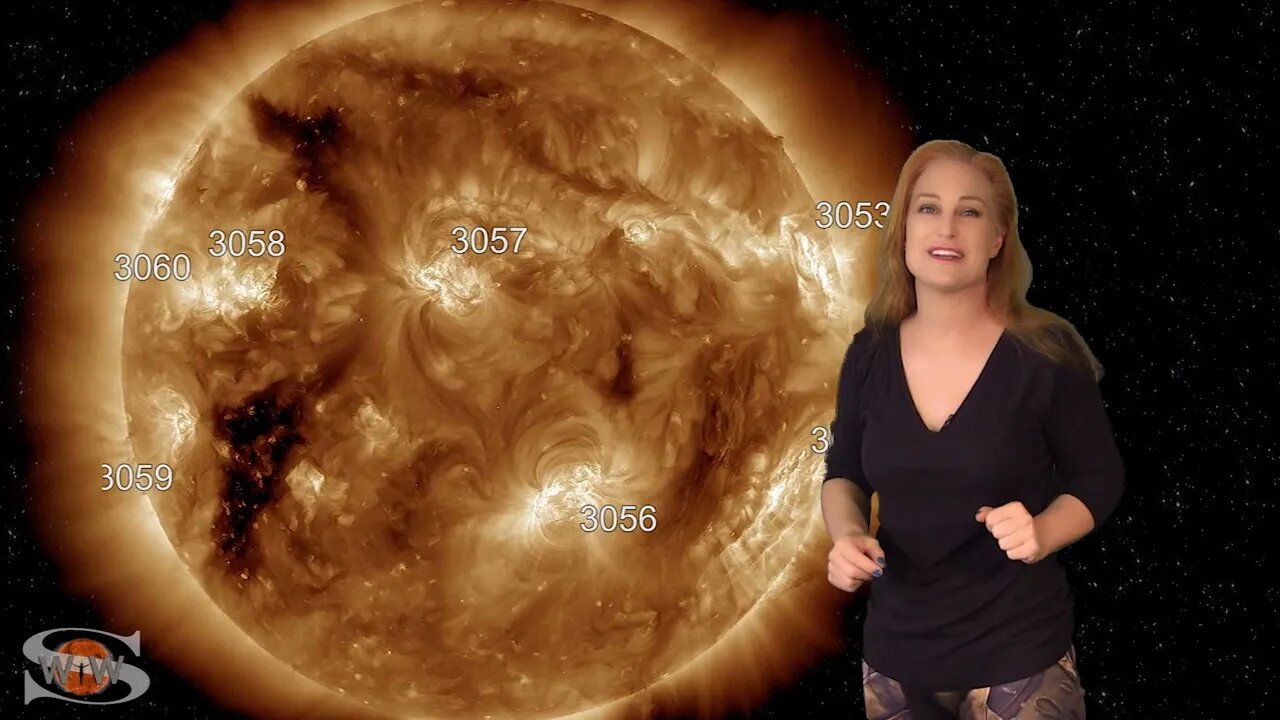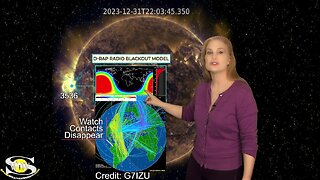Premium Only Content

A Snake-like Filament and a 1,2- Punch at Earth | Solar Storm Forecast 07.18.2022
This Space Weather News forecast sponsored in part by Millersville University:
https://www.millersville.edu/swen
This week our Sun turns up the volume and the beauty as it launches not one but two Earth-directed solar storms. The first of these cartwheels off the Sun during launch in a graceful ballet, one that will make its magnetic field orientation hard to predict when it arrives at Earth. NASA predictions show the first storm will arrive early on July 19 with the second one arriving mid-morning on the 20th (UTC time). This means we will get a 1,2-punch that could bring aurora down to mid-latitudes for several days! Aurora photographers be sure to should keep your batteries charged and cameras at the ready. Amateur radio operators have a mixed bag this week as we have many big-flare players in Earth view. This means solar flux is staying well into the triple digits and radio propagation on Earth's dayside s good, but radio blackouts are on the menu. GPS users should also stay vigilant as the high solar flux and radio blackouts make GPS reception a bit dicey, especially near dawn and dusk. Also, once the solar storms hit, GPS users should stay away from aurora on Earth's nightside. Learn the details of the coming solar storms, see the gorgeous filament eruption, and find out which big-flare regions regions are the bad actors this week!
Want early access to these forecasts, tutorials on Space Weather, & more? Visit:
https://patreon.com/SpaceweatherWoman
For daily and often hourly updates (during active times) visit me on Twitter:
https://twitter.com/TamithaSkov
For a more in-depth look at the data and images highlighted in this video see these links below.
Solar Imaging and Analysis:
SDO: http://sdo.gsfc.nasa.gov/data/
Helioviewer: http://www.helioviewer.org/
Flare Analysis: http://www.lmsal.com/solarsoft/latest_events/
Computer Aided CME Tracking CACTUS: http://www.sidc.oma.be/cactus/out/latestCMEs.html
GOES Xray: http://www.swpc.noaa.gov/rt_plots/xray_1m.html
SOHO: http://sohodata.nascom.nasa.gov/
Stereo: http://stereo.gsfc.nasa.gov/
GONG magnetic field synoptic movie: https://gong.nso.edu/data/magmap/standard_movie.html
GONG magnetic field synoptic charts: http://gong.nso.edu/data/magmap/
LMSAL Heliophysics Events HEK http://www.lmsal.com/isolsearch
Solar Wind:
DISCOVR solar wind: http://www.swpc.noaa.gov/products/real-time-solar-wind
ACE Solar Wind: http://www.swpc.noaa.gov/products/ace-real-time-solar-wind
NASA ENLIL SPIRAL: https://iswa.gsfc.nasa.gov/IswaSystemWebApp/iSWACygnetStreamer?timestamp=2038-01-23+00%3A44%3A00&window=-1&cygnetId=261
NOAA ENLIL SPIRAL: http://www.swpc.noaa.gov/products/wsa-enlil-solar-wind-prediction
Magnetosphere, Ionosphere, Atmosphere:
GOES Magnetometer: http://www.swpc.noaa.gov/products/goes-magnetometer
Ionosphere D-Region Absorption (DRAP) model: http://www.swpc.noaa.gov/products/d-region-absorption-predictions-d-rap/
Auroral Oval Ovation Products: http://www.swpc.noaa.gov/products/aurora-30-minute-forecast
Global 3-hr Kp index: http://www.swpc.noaa.gov/products/planetary-k-index
Wing Kp index prediction: http://www.swpc.noaa.gov/products/wing-kp
USGS Ground Magnetometers: http://geomag.usgs.gov/realtime/
USGS Disturbance Storm-Time (Dst): http://geomag.usgs.gov/realtime/dst/
NAIRAS Radiation Storm Model: http://sol.spacenvironment.net/raps_ops/current_files/globeView.html
Multi-Purpose Space Environment Sites:
NOAA/SWPC: http://www.swpc.noaa.gov
SOLARHAM: http://www.solarham.net/index.htm
Spaceweather: http://spaceweather.com
iSWA: http://iswa.gsfc.nasa.gov/iswa/iSWA.html
Definition of Geomagnetic Storm, Radiation Storm, and Radio Blackout Levels:
http://www.swpc.noaa.gov/NOAAscales/
None of this would be possible without the hard work and dedication of those who have provided all of this data for public use.
Images c/o NASA/ESA/CSA (most notably the superb SDO, SOHO, ACE, STEREO, CCMC, JPL & DSN teams, amazing professionals, hobbyists, institutions, organizations, agencies and amateurs such as those at the USAF/HAARP, NICT, NOAA, USGS, Environment Canada, Natural Resources Canada, Intellicast, Catatania, rice.edu, wisc.edu, sonoma.edu ucalgary.ca, rssi.ru, ohio-state.edu, solen.info, and more. Thanks for making Space Weather part of our every day dialogue.
-
 12:43
12:43
Dr. Tamitha Skov
1 year ago $0.22 earnedBiggest X-Flare of Cycle 25 & Super Storm Launch | Space Weather Spotlight 02 January 2024
607 -
 27:39
27:39
Crypto.com
31 minutes ago2025 Live AMA with Kris Marszalek, Co-Founder & CEO of Crypto.com
-
 LIVE
LIVE
Law&Crime
1 hour agoLIVE: Adelson Matriarch Murder Trial — FL v. Donna Adelson — Day 3
228 watching -
 LIVE
LIVE
JuicyJohns
1 hour ago $0.23 earned🟢#1 REBIRTH PLAYER 10.2+ KD🟢
123 watching -
 LIVE
LIVE
Surviving The Survivor: #BestGuests in True Crime
1 hour agoCourt Stream: Donna Adelson Trial DAY 3 of Testimony
47 watching -
 LIVE
LIVE
Wendy Bell Radio
5 hours agoWhat Hill Will Democrats Choose To Die On?
8,252 watching -
 LIVE
LIVE
LFA TV
3 hours agoLFA TV ALL DAY STREAM - TUESDAY 8/26/25
6,005 watching -
 1:15:15
1:15:15
JULIE GREEN MINISTRIES
3 hours agoTHE CIA HAS BEEN A GIANT IN THIS LAND THAT WILL BE TAKEN OUT
67.7K109 -
 3:58:26
3:58:26
The Bubba Army
1 day agoBURN The FLAG, Go to JAIL! - Bubba the Love Sponge® Show | 8/26/25
54.5K19 -
 29:45
29:45
DeVory Darkins
17 hours ago $7.39 earnedDemocrat Governor suffers EMBARRASSING LOSS to Trump as ICE takes Garcia into custody
27.1K74